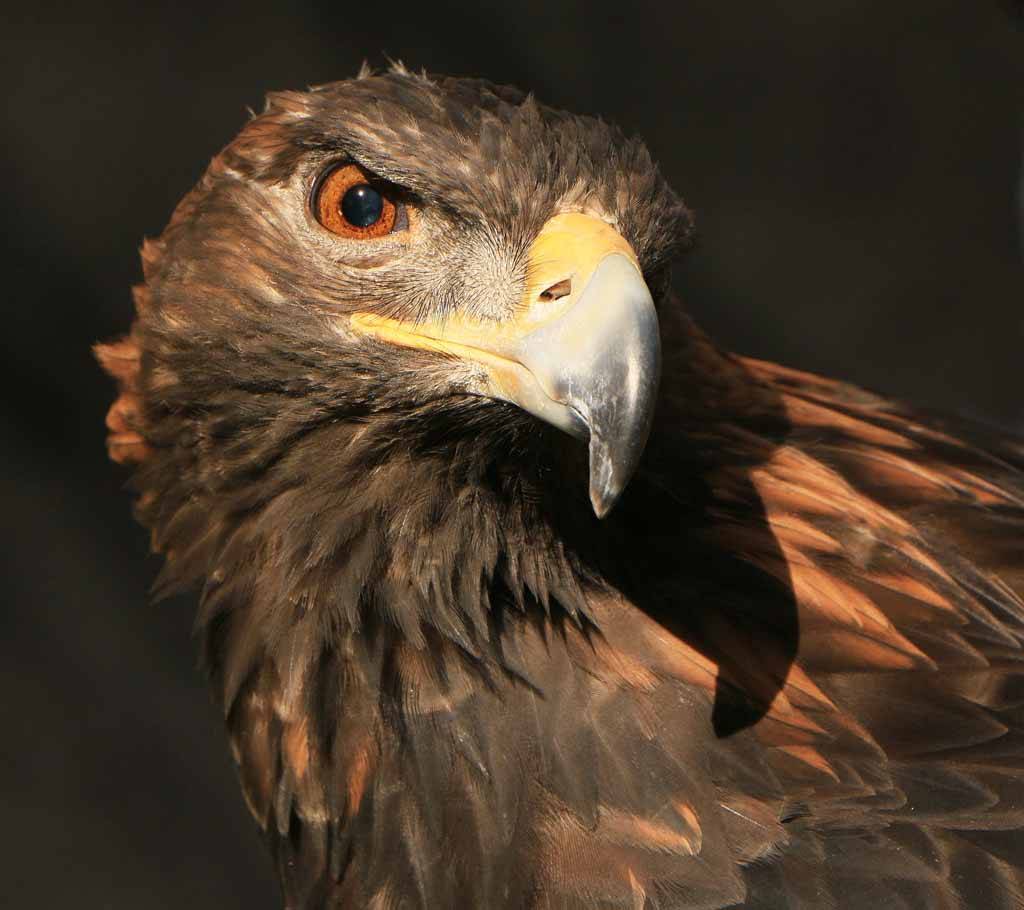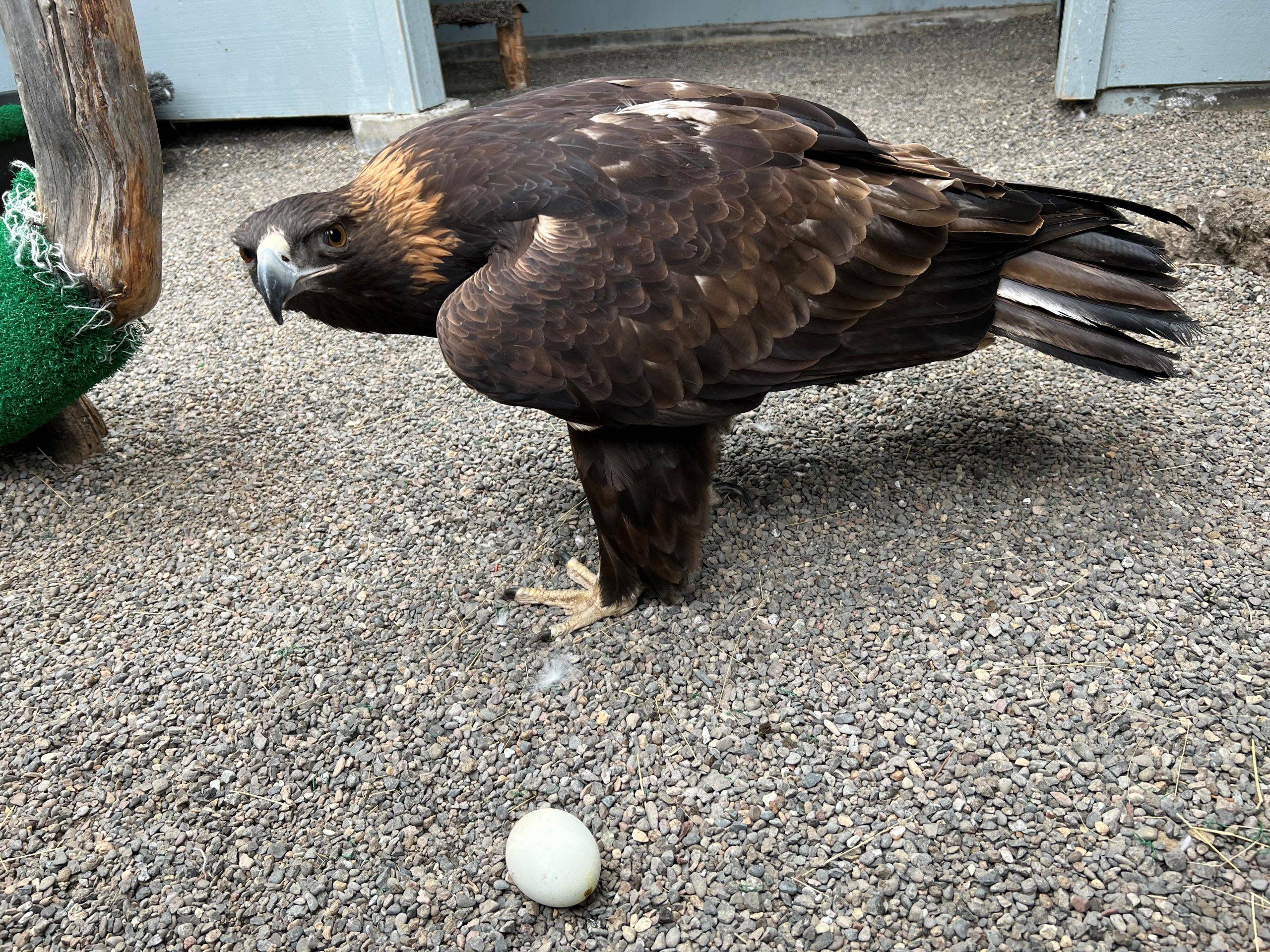ABOUT AQUILA
40 years ago, a young Golden Eagle descended onto a deer carcass. This was not unusual for the large predator. Eagles are some of the few animals capable of breaking into the tough hide of a wild ungulate. In this instance, the bird was feeding close to a road. Her wings, perfectly constructed for soaring, diving, and pursuing the tail of a rabbit through sagebrush shadows, were not equipped to break away from the wind vortex generated by a 40-ton truck moving at 60 miles per hour. When she attempted to fly away from the perceived threat, she instead tumbled onto the road and was struck a vehicle. This scenario plays out millions of times each year for birds, especially for eagles, owls, and vultures who may be lured by roadkill. It is estimated that up to 340 million birds die annually from car strikes.
After the accident, the eagle was transported to a local wildlife rehabilitation center, Sunriver Nature Center, where her injuries were treated. Despite intervention, the trauma she had sustained left her with only a fraction of her superior eyesight. She would no longer be able to soar through the open skies searching for food or care for the young she might hatch. Instead, local conservation organizations accepted the responsibility to care for her, providing her with safe shelter and food, and allowing her to continue her life. In the following four decades, this eagle provided hundreds and thousands of people the opportunity to observe the apex sky-dwelling predator up close, create a connection with her, and learn some of the amazing things that make them such an awe-inspiring species.
We called this bird Aquila, referring to the genus section of the bird’s Latin name, Aquila crysaetos. Aqulia is Latin for “eagle”, and the specific epithet, chrysaetos is Greek for “golden”, aptly describing their gilded head and nape feathers. There are two eagle species in North America, the Golden Eagle and the Bald Eagle. These birds are genetically and morphologically distinct species, and the common name of “eagle” simply refers to their enormous size. Golden Eagles belong to the Accipitridae family, and due to the feathering along their legs, their family is referred to as “booted eagles”. They are found around the globe in the northern hemisphere and most often occur in mountainous regions where steep cliffs provide vantage points and treeless plains offer unrestricted airspace. From their perches, Golden Eagles will launch into the air and pursue quarry from a high-speed dive, often exhibiting some of the most graceful and agile flights of any raptor. During the breeding season, Golden Eagles form monogamous pairs which will defend a territory and stick-built nest from animals as intimidating as Grizzly Bears. They usually lay 2-3 beige and speckled eggs, from which fuzzy white chicks will hatch within 41-45 days.
Even though Aquila was mostly blind, she learned how to interact with her environment, identify her caretakers, and even engage in enriching habits such as seasonal nest building. When she heard the approach of someone she recognized, she would softly vocalize a greeting. This greeting was much different than what is often associated with eagles on television, which is actually a Red-Tailed Hawk territorial call. Aquila’s greeting was a soft undulating cooing note that could have been missed if one wasn’t listening for it. In the spring she would drag sticks back and forth, preparing for the infertile eggs she would later lay. She was a popular visitor to classrooms and events such as the annual Eagle Watch. Children could crouch at the ground level to observe a bird almost as big as they were, and adults would be stunned by her majesty, often commenting on how they seemed to form a connection with her just by observing.
Sunriver Nature Center & Observatory’s mission is to “Inspire present and future generations to cherish and understand our natural world.” We have countless stories of visitors and students who were inspired by the massive, gentle, and majestic bird who graced us with her presence for 40 years. In the wild few Golden Eagles have been observed living past 20 years. Despite their superior hunting capabilities, food can be scarce, the elements can be harsh, and diseases and parasites all contribute to stress on a wild eagle’s body. With consistent food and protection, Aquila lived well past the life span she would have achieved outside of human care. Each year, we counted ourselves lucky she was still with us. Unfortunately, age for any biological being follows the same eventual degradation process. In January, Aquila’s health suddenly began to decline significantly. Although a thorough physical exam was performed, no direct cause could be determined. Our wildlife team consulted with the staff at Sunriver Veterinary Clinic and other wildlife veterinarians, monitored her closely, and worked to ensure she was comfortable. Aquila left us on January 26, 2024, passing peacefully. Due to the sacred nature of Golden Eagles to indigenous people, her remains will be sent to the National Eagle Repository, who oversee the Native American eagle feather program.
Aquila could have just been one more in a litany of incalculable anthropogenic-influenced tragedies that would have ended her life. Instead, she has left an indelible legacy, and she became something more than just a number in the tally. Anyone who had the opportunity to meet and see Aquila came away with a new appreciation of her and all Golden Eagles. That will continue to be her legacy with every life she touched, even now that she is gone. We hope you will continue to support her legacy at the Sunriver Nature Center & Observatory as we remember our friend Aquila.


